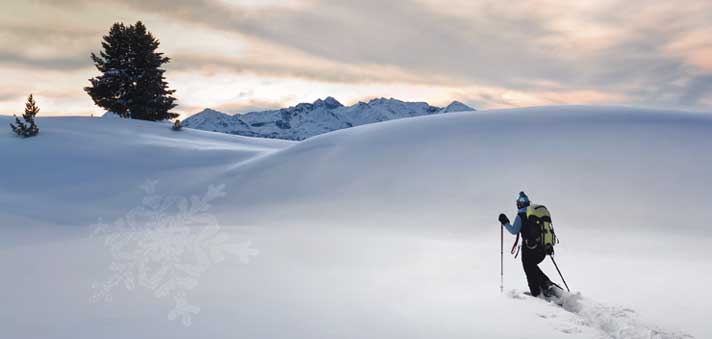

WINTER WEATHER - SNOW, IN PARTICULAR - AFFORDS EXPERIENCES THAT HELP TO PUT LIFE INTO PERSPECTIVE. NEWLY FALLEN SNOW MAKES THE WORLD NEW AGAIN. EVERYTHING IS CLEAN AND WHITE. WHEN YOU'RE THE FIRST TO CROSS ANY OPEN AREA, YOU FEEL LIKE AN EXPLORER AND A TRAILBLAZER, MARKING THE WAY FOR OTHERS TO FOLLOW...
Animal tracks and markings left by blowing grasses
and other vegetation that remain from warmer months serve as messages:
They are singular signs that humankind is not alone and that we share
the planet.
Snowshoeing on a new layer of snow gives you the opportunity to contemplate that relationship.
Outdoor winter travel does not need to be at
speed. There's an alternative to using skis, snowboards, or ice skates
to cross the season's frozen surfaces. With snowshoes, you can enjoy
winter at a different pace, whether for overland travel, recreation,
communing with nature, serious exercise, community building, seeking
isolation, or competition.
Snowshoeing has enjoyed a renaissance the last few
decades. Once necessary footwear for enabling members of native tribes
to mobilize during winter months, snowshoes are just as useful today as
they were as many as 6,000 years ago.
The concept behind snowshoes is that they spread out a person's weight across a wide area so the snowshoer doesn't sink like he or she would if just wearing shoes or boots. As an early human invention, snowshoes have a long history.
A Historical PerspectiveIn his book Snowshoeing: From Novice to Master,
author Gene Prater claimed that the invention and development of
snowshoes were as important to humankind as the invention of the wheel.
The 6,000-year history of snowshoes places their origination in central
Asia, probably as crude slabs of wood. One theory is that both snowshoes
and skis developed from this technology. As it spread to the west, the
wooden slabs became skis in what are now European countries. To the
east, the slabs were taken across the Aleutian land bridge from Asia to
North America and became snowshoes.

North America's Native American tribes further
modified snowshoes to the point of their being crucial for survival.
They were used extensively from the northwest across the plains to the
northeast.
Usually, snowshoes were made with wood frames that
had leather cords crisscrossed from side to side. Footwear was bound to
the leather webbing and/or frame.
Snowshoes played important roles not only in daily
life, but also figured prominently in war, enabling troop mobility in
winter months that was far superior to that of non-snowshoed enemies.
European settlers adopted Native American snowshoe technology, finding
it just as necessary for transportation as the natives did.

Designs reflected application - that is, form followed function. Long snowshoes with emphatically turned-up toes were developed for use in powder snow in open country. Snowshoes that were narrow in front were for pushing through brush as well as for reducing the amount of snow that accumulates on the tips. Shoes intended for climbing had wider, flatter fronts.
Native American snowshoe designs have carried into the 21st century, and basic traditional snowshoe shapes used for walking through different environments often carry the names of tribes. For example, among the basic snowshoe shapes are Huron, Yukon, Ojibwa, and Cree.
Snowshoes became a part of winter tradition, and what have become social clubs in Canada and in the United States have maintained their use - some for more than 200 years. Snowshoeing clubs have been important to the formation of snowshoe competitive and recreational events.
In the early 1900s, communities in New England organized snowshoe hikes as part of their winter recreation. These community hikes would take participants out of town to nearby farms, where they would stop for rest and refreshments, then back to town again.
Snowshoes Today
Modern snowshoes were introduced in the 1950s and
had another spurt of development in the 1970s. These tested the
applications of aluminum and plastics for frames and a variety of
synthetic and high-tech materials for the rest. Instead of a toe hole
and toe cord for binding, metal mechanical bindings are now a part of
many designs.
Through the course of the last 60 years, some of
the materials have proven to work better than others, and today's
snowshoes reflect substantial refinement. Contemporary snowshoes are
lightweight and durable.
Snowshoes are made for individuals of any size -
from children through adults. Wood-framed snowshoes are still available,
and most outfitters have snowshoes of different types and materials for
whatever your destination and application might be - casual hiking,
backpacking, or climbing.
Snowshoe size, materials, and types of bindings
can be determined with the help of experienced professionals. The
location where you snowshoe as well as the condition of the snow must be
considered. Your preferences also should be considered.
Snowshoeing is an activity for just about anyone, provided, of course, you have access to approximately six inches or more of snow. There are no restrictions on age or skill level. Men, women, and children participate in this activity, which has grown by more than 50 percent during the last decade. It is inexpensive and easy to learn. If you can walk, you can snowshoe! Plus, barring a misstep off a cliff or into a tree, it is a safe, low-impact activity that provides several health benefits.
The Benefits of Snowshoeing
The bottom line on snowshoeing is that it's one of
the best forms of exercise you can find for burning calories. It's a
relatively safe form of exercise that combines aerobics for
cardiovascular fitness, strength training, and muscle endurance.
When it comes to burning calories, snowshoe
walking is in league with jogging, racket ball, and squash. Snowshoeing
is a little more effective than the other three. Also, snowshoeing burns
approximately twice the number of calories as walking at the same
speed.
The sport of snowshoe racing is growing along with
the overall expansion of snowshoeing.
Find information about racing
events on the United States Snowshoe Association website at www.snowshoeracing.com.
Although snowshoers easily can exercise themselves
to improved health, their contact with the outdoors leads to mental and
emotional benefits as well. Plying through the snow on a cold, crisp
day and enjoying the surroundings is relaxing, and the experience often
is reflective.
That's especially true if you're the first to cross freshly fallen snow.
If you're wondering where to snowshoe, all you need is access to approximately six inches or more of snow. Consider these destinations:
- Forest trails (city, county, state, national)
- Golf courses (check for permission)
Find more locations specific to your area at www.snowlink.com
Two resources about snowshoeing:
- Snowshoeing: A Trailside Guide, by Larry Olmsted; W.W. Norton & Company
- Snowshoeing: From Novice to Master, by Gene Prater; The Mountaineers Books









